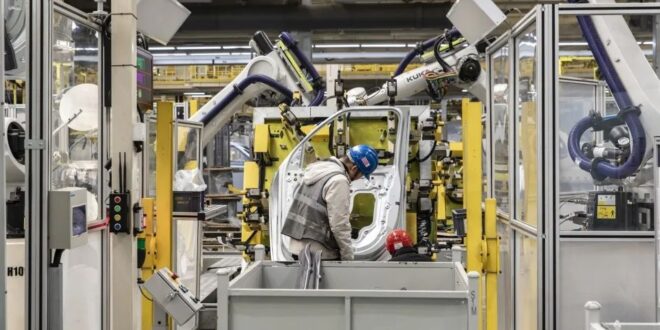SHANGHAI: A private gauge of China’s factory activity gains momentum, contrasting with official data that suggests the outlook for the nation’s manufacturers remains fragile.
The Caixin manufacturing purchasing managers index (PMI) rose to 50.8 last month from 50.7 in November, the strongest reading since August and above the estimate in a Bloomberg survey of economists. A reading above 50 indicates expansion, and anything below that points to contraction.
The release came after official data published over the weekend showed factory activity shrank in December to the lowest level in six months.
The two surveys cover different sample sizes, geographic locations and types of businesses, and the Caixin survey results generally outperformed the official ones last year.
“I think that still shows the manufacturing sector is on a fragile recovery,” said Michelle Lam, Greater China economist at Societe Generale SA, referring to the private poll.
The better performance in the Caixin poll may suggest that small and medium-sized businesses are doing “slightly better” than companies captured by the official survey, she added.
The beat in the Caixin survey wasn’t enough to boost markets. Chinese stocks extended losses yesterday, with the Hang Seng China Enterprises Index losing as much as 1.8%. The onshore benchmark CSI 300 Index was down 1.1%.
Both indexes ranked among the worst-performing key gauges in the region.
The offshore yuan was little changed at around 7.13 per US dollar, while the yield on 10-year government bonds was steady at about 2.55%.
“The magnitude of the beat is smaller than the disappointment of the National Bureau of Statistics (NBS) PMI data,” said Marvin Chen, an analyst with Bloomberg Intelligence, referring to the survey published by the NBS.
“When taken together, it still points to an uncertain recovery.”
PMI surveys offer the earliest indication each month about the trajectory of the Chinese economy.
The country’s recovery from the pandemic has been bumpy over the past year as the property crisis weighs on sentiment and confidence. Geopolitical strains also pose a challenge.
In his annual New Year address, President Xi Jinping pledged to strengthen economic momentum and job creation.
The speech also acknowledged that some companies and citizens had endured a difficult 2023, a rare admission of domestic headwinds.
Xi touted China’s “manufacturing prowess” during the address, rattling off a list of homegrown projects, including the nation’s space programmes and electric cars.
Chinese factories have been grappling with subdued demand and sluggish profits, official data showed.
Investment by manufacturers has held up, however, as Beijing has devoted financial resources and pushed favourable policies as it looks to support breakthroughs in advanced manufacturing and cutting-edge technology.
Manufacturers reported stronger increases in output and new orders last month, according to a statement released by Caixin and S&P Global yesterday, accompanying the latest survey.
Even so, business confidence for the year ahead was weak.
Staffing levels fell for a fourth straight month, the survey showed, reflecting a cautious approach to hiring. Deflation pressure also lingered.
Beijing ramped up stimulus in the final months of 2023 in a bid to secure an official growth target for the year of around 5%.
Authorities are expected to set the goal for this year at a similar level. That may require more support from the government.
The country’s biggest state-owned banks lowered deposit rates last month for the third time in 2023, fuelling expectations that the move will create more wiggle room for the central bank to cut lending rates early this year.
The People’s Bank of China may reduce interest rates on its policy loans this month to boost weak domestic demand and support the economy’s anemic appetite for credit, SWS Research Co analysts, including Wang Sheng, wrote in a note.
Lenders could also cut lending rates by a larger margin than the policy rate reductions, they added.
The yuan’s performance may affect any timing of rate cuts, according to Robert Carnell, regional head of research for Asia Pacific at ING Groep NV.
“It’s not that they aren’t concerned about weak growth, it’s just that they are constrained in their actions,” he said.
“Net foreign direct investment flows are negative, and authorities may be worried about intensifying capital outflows.”
He said he doesn’t expect rates to be cut until the yuan traded offshore gets closer to seven per US dollar. — Bloomberg
 BeritaKini.biz Berita Viral Terkini di Malaysia
BeritaKini.biz Berita Viral Terkini di Malaysia





